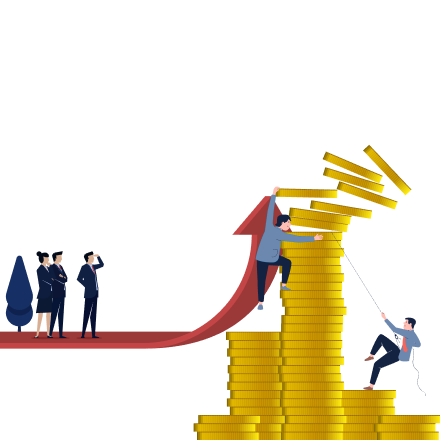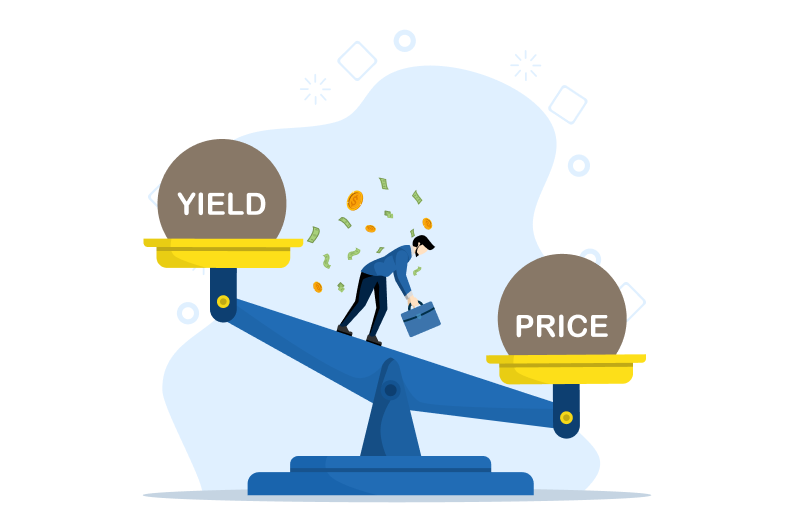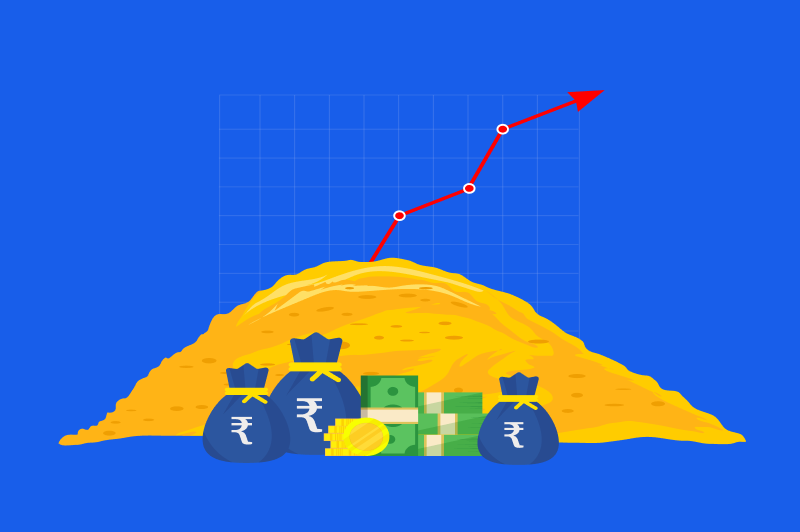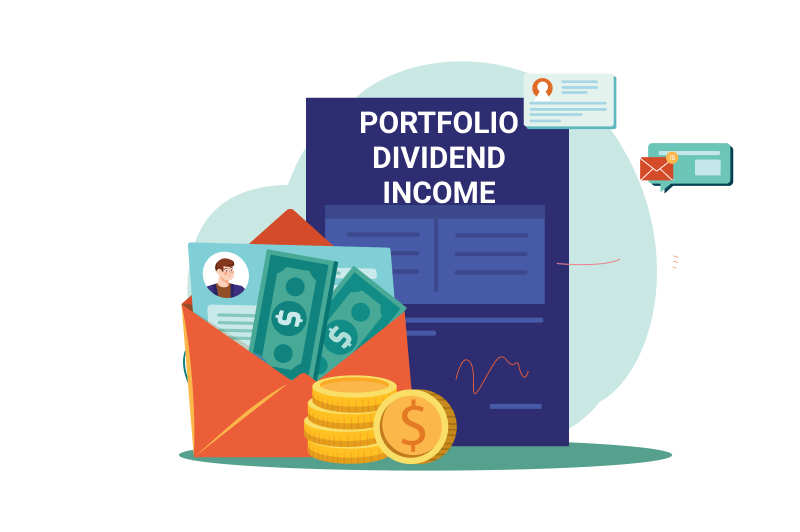Dividend Yield 101: What It Is and Why It Matters for Investors

Dividend yield is a ratio that measures the annual dividends a company pays relative to its stock price.
Dividend yield gives you a good sense of how much dividend income you can expect to receive for every share of a dividend stock you own.
By the end of our guide, you’ll understand how to calculate dividend yield and apply it as part of your dividend investing approach.
From researching dividend-paying stocks to anticipating how much income you can expect to receive from a dividend stock or dividend stock portfolio, dividend yield is a key metric that can help you get the most out of your investments.
Dividend Yield: How To Calculate It
To calculate dividend yield, simply divide a company’s annual dividend by the current price of its stock.
Dividend yield = annual dividend / stock price
While a straightforward calculation, you must take multiple factors into consideration when looking at a dividend stock’s yield. Factors related solely to the stock/company you’re assessing as well as the circumstances specific to your situation. Your investing goals and objectives influence how you make sense of dividend yield.
Dividend Yield Examples

Let’s start with a basic example to calculate dividend yield.
A company pays an $1.00 annual dividend. Its current stock price is $50.00. Using the formula above, the mathematical calculation looks like this:
0.02 = $1.00 / $50.00
When you divide $1.00 (the annual dividend) by $50.00 (the current stock price) you get 0.02. To get the percentage, move the decimal point over two places to the right. So the dividend yield in this hypothetical example is 2.0%.
2.0% = $1.00 / $50.00
You can save yourself time and effort by simply looking up the stock quote for a company to see its dividend yield. Most popular stock quote platforms, such as Google Finance, include dividend yield along with share price and other key metrics. Here’s an example of how this looks.
Home Depot (HD) has a dividend yield of 2.78%.
Of course, you can come to this number on your own. You just need to find Home Depot’s annual dividend payment. While some stock quote platforms include this information, Google Finance does not. Plus, it’s best to go directly to a company’s investor relations website for the most accurate and up-to-date information.
To do this, simply Google the company’s name followed by dividend history (e.g., “Home Depot dividend history”). In the first few results, you should see a link to the company’s dividend history on its investor relations page.
Home Depot’s dividend history looks like this:
In this case, take the most recent dividend payment of $2.09 and multiply it by four. Because Home Depot, like most companies, pays its annual dividend in four quarterly payments, this is the number we need to calculate the stock’s dividend yield. When you multiply $2.09 by four, you get $8.36, which is Home Depot’s annual dividend for 2023.
Next, we divide $8.36 by Home Depot’s current $300.54 share price (as of April 29, 2023) and get 0.0278. Move the decimal point over two places to the right to generate the yield in percentage form – 2.78%. This matches with Google Finance’s data so you can confirm that you got things right.
2.78% = $8.36 / $300.54
Dividend Yield: Why It Matters
You can use dividend yield to assess the quality and sustainability of a company’s dividend payment. We focus on this aspect of dividend yield in our guide that looks at a potential red flag for dividend stocks – dividend yield traps.
In this guide, we focus on using dividend yield to get a read on how much dividend income you can expect to receive from individual dividend stocks you own as well as your larger dividend stock portfolio. Evaluating dividend yield is a key component of the popular strategy known as dividend growth investing.
Dividend Income

As we explain in our guides to dividend investing, people tend to invest in dividend stocks as a way to generate regular income from their positions. Dividend yield can help you anticipate how much income you can expect to receive from your dividend stocks.
Why this income matters and how you use it depends on your specific circumstances, such as your stage in life and investing goals and objectives.
Some dividend growth investors are in the portfolio building stage. These investors buy and hold well-established companies with attractive and increasing dividend payments, such as dividend aristocrats. Over time, the effects of compounding can result in significant regular dividend income.
Dividend investors often use this income to help pay some or all of their expenses. While you can apply this strategy at any age, it tends to be one way to help fund semi or full retirement.
Let’s use the Home Depot example to illustrate how this can look.
Single Stock Dividend Income
If you own one share of Home Depot stock, valued at $300.54 and yielding 2.78%, you can expect to receive $8.36 in dividend income annually on that one share.
We know our math is correct because Home Depot’s annual dividend payment per share is $8.36. Of course, $8.36 can’t cover many expenses these days, especially over the course of a year.
However, if you own 100 shares of Home Depot stock, valued at $30,054 and yielding 2.78% in our example, you can expect to receive $836 in annual dividend income – paid out in quarterly installments of $209 each – from this position. Also, not a huge amount of money, but certainly more meaningful.
Consider an investor with 1,000 shares of Home Depot stock with a value of $300,540. Using a 2.78% yield, this holding generates $8,355 annually, or $2,088.75 every quarter. Now we’re talking.
You can figure out how much dividend income in dollars your position size yields by doing basic math.
Dividend income (in dollars) = position size (in dollars) X dividend yield
In the last Home Depot example, it looks like this.
$8,355 = $300,540 X .0278 (or 2.78%)
This works out to $696.25 a month.
Here again, this amount of money will not cover most people’s costs of living. However it can cover expenses such as a car payment and then some in more than a few households.
You get the idea. And you probably take two key points away from this illustration:
- Dividend income can be (potentially) lucrative as you build out positions in dividend stocks.
- But it takes time – and, more so, a large amount of capital – to generate enough dividend income to cover a significant number of expenses, let alone a majority or all of your cost of living.
Therefore, dividend investors often use dividend income as a supplement to other sources of income and cash flow.
All of this said, common investing wisdom says you should not put all of your eggs in one basket. You’re more likely – and probably better off – owning a variety of dividend-paying (and non-dividend paying) stocks. To this end, you can calculate dividend yield on your entire portfolio.
Portfolio Dividend Income

Unfortunately, most reliable calculators that determine the dividend yield of your entire portfolio cost money to use. You most often can access these tools through your financial advisor or if you have a relationship with a large investment firm such as Fidelity.
On the bright side, you don’t have to do complicated math, such as averaging out the yield on multiple stocks, all with different values and position sizes. Instead, you can run this relatively simple math on your entire portfolio of dividend stocks to estimate your portfolio’s dividend yield.
From the earlier example, let’s say you own 100 shares of Home Depot with a value of $30,054. It produces $836 in annual dividend income. From there, you run through the rest of your holdings.
Consider this hypothetical pair of holdings flowing from the HD position:
- 100 shares of Apple (AAPL) with a value of $16,968, generating $92 in annual dividend income, based on AAPL’s 0.54% dividend yield, as of April 29, 2023.
- 500 shares of Starbucks (SBUX) with a value of $57,145, generating $1,057 in annual dividend income, based on SBUX’s 1.85% dividend yield, as of April 29, 2023.
Adding everything up, your total dividend portfolio has a value of $104,167 and produces $1,985 in annual dividend income. To determine your portfolio’s total yield, you divide the annual dividend income by your portfolio’s total value. Move the decimal point over two places to the right to see your dividend yield in percentage form.
Total portfolio dividend yield = annual dividend income / portfolio total value
1.9% (0.019) = $1,985 / $104,167
Your hypothetical portfolio of HD, AAPL and SBUX yields nearly 2.0%.
This exercise underscores the two earlier takeaways. You need a lot of money and/or stocks with high yields for a dividend stock portfolio to throw off enough income to cover a significant number of your expenses or amount of your cost of living.
While it’s not impossible to get there, it takes time, patience, money and know-how. Because, in the quest to bring in income using dividend stocks, investors sometimes make mistakes.
Dividend Yield: Using It In Your Research
As noted earlier, you can use dividend yield to do more than give yourself visibility on how much income you can expect to receive from individual dividend stocks or a larger dividend stock portfolio.
You can use dividend yield to evaluate the veracity of a company’s dividend. This evaluation will often influence, if not dictate your buy, sell and hold decisions on dividend stocks.
Evaluating Dividend Yield
See our guide on yield traps for a complete overview of this important topic.
In relation to dividend income as a way to help pay for some or all of your cost of living, beware of stocks with tantalizingly high dividend yields. The examples in this guide have common, but relatively low yields.
This is not a bad thing.
Because, as you have learned, dividend yield is a function of stock price. As a stock price goes down, the dividend yield goes up, assuming the dividend payment holds constant.
Looking back to our initial example of a $50 stock paying a $1.00 annual dividend for a yield of 2.0%. Cut the stock price in half – to $25 – and suddenly that stock yields 4.0%, even though the dividend payment has not changed.
It doesn’t take a financial professional to figure out that a stock price that loses half of its value is almost always not a good thing. This can indicate problems at a company. Naturally it follows that a dividend yield that increases quickly or seems too good to be true, often is. Not always, but often.
These types of seemingly attractive dividend yields can be red flags. We call them yield traps. Our guide to yield traps covers them in great detail.
FAQs
Why is Apple’s dividend yield so low?
Apple’s yield appears low, in part, because of its, over time, rising stock price. Apple also holds back a significant portion of its profits to reinvest in its business rather than pay them out as dividends. This is reflected in Apple’s healthy payout ratio, another key metric we cover in detail in this guide.
What is a good dividend yield?
There’s no general answer to this question. Many factors contribute to what makes a yield good, not so good or bad. Payout ratio is a better measure of the health of a company’s dividend payment.
Are double-digit dividend yields bad?
Generally speaking, they’re a huge red flag. Here again, look at payout ratio for a complete assessment before making a buy, sell or hold decision on the basis of dividend yield alone. Also, consider how a company’s dividend yield looks relative to its peers in the same or similar industries.
I own a stock that pays a huge dividend, but the price of the stock is crashing. What should I do?
We can’t answer this question. You have to assess the company’s specific situation to see if the falling stock is temporary or if it indicates trouble with the company’s business.
What is a dividend cut?
When a company reduces its dividend payment, we call it a dividend cut. This often signals issues with revenue and profitability. This is another situation where a full understanding of what’s happening with the business in question can help you make the most informed decision.
Do some people actually live off of their dividend income?
Yes. While quite a feat, it’s not an impossible goal to reach. If you have a dividend portfolio valued at $1,000,000 – often a target number for investors – and it yields 5.0%, you are earning $50,000 in annual dividend income. Many people can live on $50,000 a year. It really depends on your personal financial situation.
Conclusion
For many investors, buying and holding dividend stocks is all about generating income.
Dividend yield functions as a measure of how much dividend income you can expect to receive relative to the value of an individual stock position or larger portfolio.
As a company’s dividend payment and stock price changes, so does its dividend yield. This movement gives investors insight into the amount of dividend income they can expect to receive as well as the health and sustainability of a company’s dividend payment.
Using basic math, you can keep tabs on the dividend yield of your holdings to help you determine the role dividend income can play in your budget.

